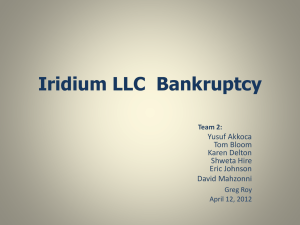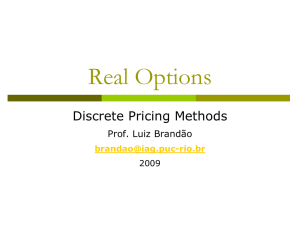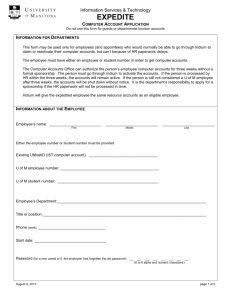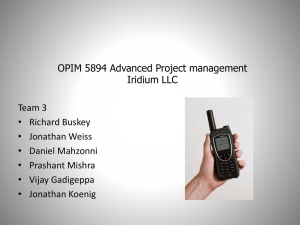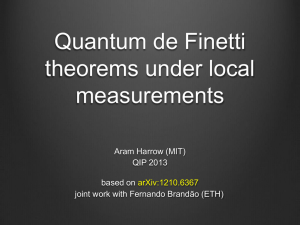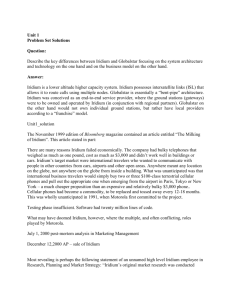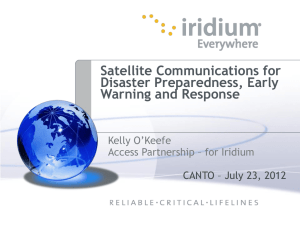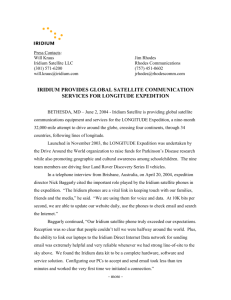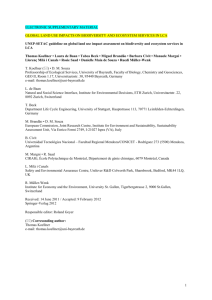Project Cash Flows
advertisement
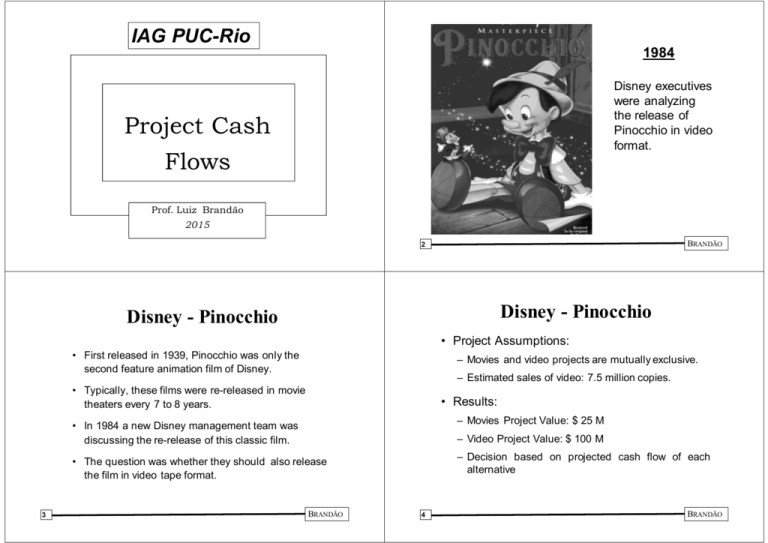
IAG PUC-Rio 1984 Disney executives were analyzing the release of Pinocchio in video format. Project Cash Flows Prof. Luiz Brandão 2015 BRANDÃO 2 Disney - Pinocchio Disney - Pinocchio • Project Assumptions: • First released in 1939, Pinocchio was only the second feature animation film of Disney. – Movies and video projects are mutually exclusive. – Estimated sales of video: 7.5 million copies. • Typically, these films were re-released in movie theaters every 7 to 8 years. • Results: – Movies Project Value: $ 25 M • In 1984 a new Disney management team was discussing the re-release of this classic film. – Video Project Value: $ 100 M – Decision based on projected cash flow of each alternative • The question was whether they should also release the film in video tape format. 3 BRANDÃO 4 BRANDÃO What happened What happened Disney – Videos Sales (million) 12,5 Disney - Videos Sales (million) 40,0 Bambi The Lion King Mogli 10,0 30,0 Cinderella Alladin Beauty and the Beast 7,5 20,0 5,0 2,5 Lady and the Tramp Sleeping Beauty Pinocchio 10,0 - 85 86 87 88 89 BRANDÃO 5 90 93 94 BRANDÃO 6 Project Cash Flows Project Cash Flows • Depreciation Incremental Flows • Opportunity Costs x • Collateral effects Total Flows 7 91 • Sunk Costs BRANDÃO 8 BRANDÃO 9 BRANDÃO BRANDÃO 10 Project Cash Flows • Working capital • Indirect Costs • Interest expenses • Inflation 11 BRANDÃO 12 BRANDÃO Efeitos Colaterais – Canibalização • 13 Convention One of the bigger surprises of Apple’s 2012 earnings was the revelation that Mac sales declined. Compared to the same quarter a year ago when it sold 5.2 million Macs, Apple sold 22 percent fewer, or 4.1 million. • The quick explanation about why Apple sold fewer Macs was that the iPad and new iPad mini were favored by buyers • CEO Tim Cook explains: • “We know iPad is cannibalizing the Mac, but that doesn’t worry us. On iPad in particular, we have the mother of all opportunities here because the Windows market is much larger than the Mac market. It’s clear it’s already cannibalizing some. “I’ve said for three years now that I believe the tablet market will be larger than the PC market at some point, and I still believe that.” • Cash Flow representations 0 1 2 Continuous CF Continuous CF Continuous CF Discrete Cash Flows BRANDÃO Problems with Cash Flow Projections BRANDÃO 14 Case Study: Iridium Project 15 3 BRANDÃO • Original document with the first description of the Iridium system (1988) • Collection: Smithsonian Museum, Washington DC BRANDÃO 18 Iridium World Comunications Iridium • 1991: Motorola sets Iridium as an independent company through a "Project Finance" to develop and operate the network. • Global mobile satellite designed by Motorola • Objective: To allow access to the worldwide phone network from anywhere in the globe. 19 • This allows other partners to join the business, reducing the risk for Motorola. • Planned investment: $ 2.5 billion, including 66 communication satellites and seven ground stations. • 1992: Iridium hires Motorola for U.S. $ 3.37 billion to develop, build and implement the system. • Forecast: 5 million subscribers by 2002 • Motorola becomes the main supplier of Iridium. BRANDÃO 20 BRANDÃO The Consortium • An International Consortium of 19 companies is formed to make the project viable – Motorola, Siemens, Raytheon, HP – Great Wall of China Industry Corporation – Khrunichev Space Center of Russia – Korea Mobile Telecomm Corp. – Lockheed, McDonnell Douglas, Sprint – Italian STET and 15 regional operating franchises 21 BRANDÃO BRANDÃO 22 Project Financing • With the establishment of Iridium LLC and the entry of new participants, Motorola reduced its stake in the business to 25% • Large geographic and technological diversity of the participants. • Project starts with equity investment • 1993: Partners provided US$800 million • 1994: $1.6 billion of equity, plus $800 million of debt. • 1995: Iridium receives operating license 23 BRANDÃO 24 BRANDÃO Market & Target Audience Project Financing • 1997: A $ 750 million line of credit is secured, and $240 million in company stock are offered to the public at a price of $ 21 per share. • In a few months the stock price rises to $ 70. • Technical difficulties increase the project cost to $ 5.5 billion. • Population of remote areas with no other form of phone service. • 1998: All satellites already in orbit and commercial operation begins • Break even point: 600,000 subscribers needed by the end of 1999. • Launched a worldwide marketing campaign at a cost of $160 million BRANDÃO 25 • Target Audience: Travelers needing constant phone access, such as businessmen and professionals. Problems Problems • Portable device availability delays delivery to subscribers. • As a manufacturer, the main goal of Motorola, as sponsor of the project, was to sell equipment. • Connection problems because Iridium requires line of sight to satellite, and thus does not work in closed areas such as vehicles and offices. • Marketing error by offering Iridium as a substitute to cell phone. • Iridium is a company that provides services, which is outside of Motorola´s field of expertise. • Service had significantly higher rates than the competitor (about 10X greater), and phone weighted over one pound. • High cost of service put itout of reach part of their target audience. • Low quality analog signal when the phones were already migrating to digital service. 27 BRANDÃO 26 BRANDÃO 28 BRANDÃO Problems Conclusions • Technical difficulties on an ambitious project substantially increased costs originally budgeted. • By July 1999 only 15,000 units had been sold. • Marketing error when Iridium was sold as a substitute for ordinary cell phones. • The expected monthly revenue of $30 million was only $1.5 million • Technological evolution on cell phones during the ten years of maturation became a serious competitor to Iridium, which is an analog system, with maximum speed of 2400 baud. • In July 1999, the shortterm debt was $800 million that the company failed to honor. • Actual Cash Flow different from initial estimates. • The assets of Iridium LLC company, now bankrupt, were bought by a group of private investors who founded Iridium Satellite LLC operating system that continues to this day. • In August 1999, Iridium filed for bankruptcy, but failed to recover and was declared bankrupt in March 2000. BRANDÃO 29 BRANDÃO 30 Ex 1: Item Year 0 Gross Revenues Expenses Exercises Depreciation Year 1 Year 2 Year 3 Year 4 Year 5 Year 6 4.000 10.000 15.000 15.000 15.000 10.000 (4.000) (6.000) (8.000) (8.000) (8.000) (6000) (1.500) (1.500) (1.500) (1.500) (1.500) (1.500) EBIT Tax (35%) Net Income Depreciation Changes in WC (500) (1.000) (1.000) (2.000) (0) 2.000 2.500 CAPEX (3.000) (6.000) Residual Value 2.000 Free Cash Flow 31 BRANDÃO 32 BRANDÃO SpectroMed Ltd. Project • Managers of SpectroMed are meeting with the shareholders to decide on a new project investment opportunity. • You are analyzing a project that has a total duration of 7 years. The required investment is $600,000, with another $1.2 million to be invested by the end of the third year of operation for a projected expansion. • If the project is implemented, the initial investment will be $120,000 for the new facilities and $25,000 for working capital, which will be fully funded by the shareholders. • Depreciation is $200,000 per year, increasing to $300,000 starting in year 4. The incremental net revenue (revenue expenses) to be generated by this project is $400,000 per year, before depreciation, increasing to $600,000 from year 4 onwards. • The project has a four year life, gross revenues of $70,000 in the first year and $ 200,000 in each of the remaining years, and a tax rate of 25%. Costs represent 65% of gross revenue and depreciation is linear during this period. – If the company's cost of capital is 15% per year, and the tax rate is 35%, what is the NPV and IRR of this project? • The shareholders expect a return of 20%. Do you recommend investing in this project? – Should the company invest in it? – Graph the NPV for discount rates between 0 and 40%. BRANDÃO 33 BRANDÃO 34 IAG PUC-Rio ErgoSoft • Ergosoft is analyzing the feasibility of a five year project. • The project requires an immediate investment of $600,000, followed by another $900,000 by the end of the third year. Project Cash Flows • The initial investment with be depreciated linearly in three years at the rate of $200,000 per year, followed by a $450,000 depreciation in years 4 and 5. The net incremental revenues (revenues – expenses) generated by the project are constant at $400,000 per year before depreciation, and increase to $600,000 per year from year 4 onwards. • Assume that the firm´s cost of capital is 17% per year, and that the tax bracket is 30%. Prof. Luiz Brandão • What is the NPV and IRR of this project? What is your recommendation to the firm? 35 • 2015 BRANDÃO 36 BRANDÃO
